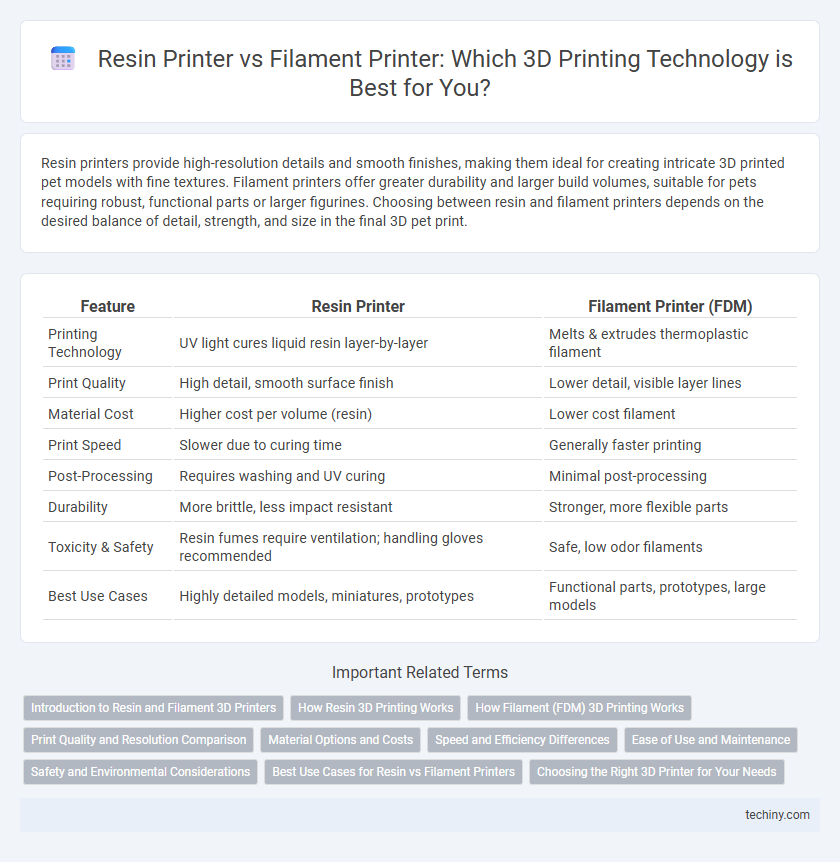Resin printers provide high-resolution details and smooth finishes, making them ideal for creating intricate 3D printed pet models with fine textures. Filament printers offer greater durability and larger build volumes, suitable for pets requiring robust, functional parts or larger figurines. Choosing between resin and filament printers depends on the desired balance of detail, strength, and size in the final 3D pet print.
Table of Comparison
| Feature | Resin Printer | Filament Printer (FDM) |
|---|---|---|
| Printing Technology | UV light cures liquid resin layer-by-layer | Melts & extrudes thermoplastic filament |
| Print Quality | High detail, smooth surface finish | Lower detail, visible layer lines |
| Material Cost | Higher cost per volume (resin) | Lower cost filament |
| Print Speed | Slower due to curing time | Generally faster printing |
| Post-Processing | Requires washing and UV curing | Minimal post-processing |
| Durability | More brittle, less impact resistant | Stronger, more flexible parts |
| Toxicity & Safety | Resin fumes require ventilation; handling gloves recommended | Safe, low odor filaments |
| Best Use Cases | Highly detailed models, miniatures, prototypes | Functional parts, prototypes, large models |
Introduction to Resin and Filament 3D Printers
Resin 3D printers use photopolymer resins cured by UV light to create highly detailed and smooth models, ideal for intricate designs and fine surface finishes. Filament 3D printers, such as FDM machines, extrude thermoplastic filaments like PLA or ABS layer-by-layer, offering versatility and ease of use for larger and more durable prototypes. Choosing between resin and filament printers depends on factors like required print resolution, material properties, and application specificity.
How Resin 3D Printing Works
Resin 3D printing operates through a process called stereolithography (SLA), where a UV laser or light source selectively cures liquid photopolymer resin layer by layer. Each layer solidifies as the light hardens specific areas, creating high-resolution, detailed prints with smooth surface finishes. This method contrasts filament printers that extrude melted thermoplastic, offering superior precision and fine detail in resin printing.
How Filament (FDM) 3D Printing Works
Filament (FDM) 3D printing operates by heating a thermoplastic filament until it melts and extruding it layer by layer through a precise nozzle onto a build platform. The filament cools and solidifies quickly, allowing complex shapes to be built with high durability and strength, suitable for functional prototypes and end-use parts. FDM technology offers broad material compatibility, including PLA, ABS, PETG, and flexible filaments, making it a versatile choice for diverse 3D printing applications.
Print Quality and Resolution Comparison
Resin printers deliver superior print quality and higher resolution compared to filament printers due to their use of photopolymerization technology, which cures liquid resin layer-by-layer with precision light sources. The typical layer height in resin printing ranges from 25 to 100 microns, enabling intricate and highly detailed models, whereas filament printers usually achieve 100 to 300 microns, resulting in less refined surfaces. This precision advantage makes resin printers ideal for applications demanding fine detail such as jewelry, dental models, and complex prototypes.
Material Options and Costs
Resin printers utilize photopolymer resins that cure layer by layer, offering high detail and smooth finishes but often at a higher material cost compared to filament printers. Filament printers use thermoplastic filaments like PLA, ABS, or PETG, which are generally more affordable and available in a wider range of material types and colors. While resin materials provide superior surface quality for intricate models, filament options offer greater versatility and lower ongoing expenses for larger or functional prints.
Speed and Efficiency Differences
Resin printers excel in producing highly detailed models with faster layer curing times, making them more efficient for intricate designs. Filament printers generally have slower print speeds due to the extrusion process but offer larger build volumes suitable for bigger projects. While resin printing is faster for small, detailed parts, filament printing balances speed and efficiency for larger, less detailed objects.
Ease of Use and Maintenance
Resin printers offer high-detail prints with smooth finishes but require more maintenance, including regular resin refills, careful handling of toxic materials, and frequent cleaning of vats and build plates. Filament printers are generally easier to use and maintain, with less post-processing needed and simple filament replacement, making them more user-friendly for beginners. Both systems benefit from routine calibration, but filament printers demand less intensive upkeep, reducing downtime and complexity.
Safety and Environmental Considerations
Resin printers emit volatile organic compounds (VOCs) and require careful handling of liquid resins, which can be toxic and irritate skin or lungs, necessitating the use of gloves and proper ventilation. Filament printers typically use thermoplastic materials like PLA or ABS, which pose fewer immediate health risks and produce less odor, but can still emit ultra-fine particles during printing. Environmentally, resin waste must be disposed of as hazardous material, while filament leftovers are less toxic but contribute to plastic waste, highlighting the importance of responsible material management in both printing methods.
Best Use Cases for Resin vs Filament Printers
Resin printers excel in producing highly detailed, smooth-surfaced models ideal for miniatures, jewelry prototypes, and dental molds, where precision and fine features are crucial. Filament printers are best suited for larger-scale objects, functional parts, and prototypes that require durability and versatility in materials such as PLA, ABS, and PETG. Choosing between resin and filament depends on the project's resolution demands, material properties, and intended application, with resin favored for intricate designs and filament preferred for robust, practical components.
Choosing the Right 3D Printer for Your Needs
Resin printers offer superior detail and smooth surface finishes, making them ideal for intricate models, jewelry, and dental applications, while filament printers excel in larger builds and functional prototypes due to their affordability and material versatility. Choosing the right 3D printer depends on factors such as print resolution requirements, material properties, budget, and intended use cases. Understanding these differences ensures optimal investment, maximizing both print quality and production efficiency.
Resin Printer vs Filament Printer Infographic

 techiny.com
techiny.com